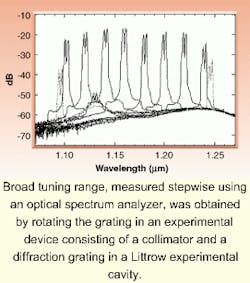Four researchers from the Center for High Technology Materials at the University of New Mexico (UNM; Albuquerque) are spinning their quantum-dot (QD) laser research into a company that will offer lasers for telecommunication applications. The company, Zia Laser Inc. (Albuquerque, NM), is developing a low-threshold-current QD laser with a continuous tuning range from 1400 to 1650 nm to cover the entire fiberoptic-telecommunications bandwidth range that also makes use of erbium-doped fiber amplifiers.
When Zia first incorporated in May, the focus was on high-power quantum-well lasers—already developed for lidar and free-space communication applications—according to Timothy Newell, a research assistant professor at UNM and secretary of Zia Laser. The group switched to quantum dots instead because of favorable performance factors, such as a low threshold current.
"QD lasers, due to their small physical dimension and low density of states, achieve inversion and lasing at much lower injection-current densities than double heterostructure or quantum well lasers," said Petros Varangis, a research assistant professor at UNM and president of Zia. "We have recently demonstrated the lowest-threshold room-temperature operation of QD lasers at 1.3-µm wavelength." They required only 16-A/cm2 injection current density when the facets were coated for high reflectivity.
Another advantage of quantum dots, according to Varangis is a broad tuning range. The group already has achieved continuous tuning between 1033 and 1234 nm on a gallium arsenide (GaAs) substrate with a bias variation between 0.3 and 2.9 kA/cm2 (see figure).1,2 The researchers also have demonstrated ground-state laser emission on indium phosphide (InP) quantum-dot substrates between 1650 and 1680 nm, and they point to demonstrations of excited-state lasing at 1580 nm as evidence that the desired 250-nm, continuous tuning across the telecommunications range is a viable objective.3
Overall, the QD laser technology promises desirable characteristics for dense wavelength-division multiplexing (DWDM), such as ultralow-frequency chirping and narrow spectral linewidths at high modulation frequencies, Varangis said. "Typically, the alpha parameter of a semiconductor laser [which contributes to frequency chirp and spectral linewidth] is 2 or greater. In contrast we have demonstrated that a QD laser shows an alpha parameter as low as 0.1." In addition to low chirp and narrow linewidth, such devices are expected to demonstrate reduced sensitivity to optical feedback and a resistance to filament formation, Varangis said.4
The researchers expect to produce prototypes in about six months and products in about nine months, Newell said. Currently they are still developing the technology while talking with venture capitalists about funding, and to interested companies, such as New Focus (Santa Clara, CA) and Nortel (Brampton, Ontario, Canada) about potential commercial relationships. The other officers of the corporation include secretary Luke Lester, an associate professor at UNM who leads the academic research team and vice president Andreas Stintz, a member of the UNM research staff.
REFERENCES
- P. M. Varangis et al., Elect. Lett., accepted for publication (2000).
- H. Li et al., IEEE Photon. Tech. Lett. 12(7) 759 (2000).
- L. F. Lester et al., postdeadline paper in 17th IEEE International Semiconductor Laser Conference, Monterey, CA (Sept. 25-28, 2000).
- T. C. Newell et al., IEEE Photon. Tech. Lett. 11, 1527 (1999).
About the Author
Hassaun A. Jones-Bey
Senior Editor and Freelance Writer
Hassaun A. Jones-Bey was a senior editor and then freelance writer for Laser Focus World.
